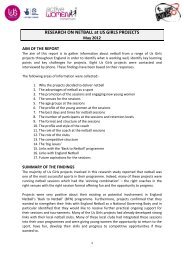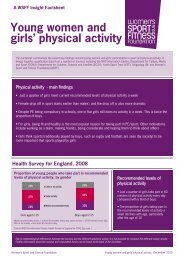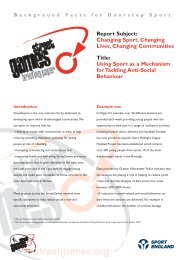Framework for Building a Participation Legacy - StreetGames
Framework for Building a Participation Legacy - StreetGames
Framework for Building a Participation Legacy - StreetGames
You also want an ePaper? Increase the reach of your titles
YUMPU automatically turns print PDFs into web optimized ePapers that Google loves.
<strong>Framework</strong> <strong>for</strong> <strong>Building</strong> a <strong>Participation</strong> <strong>Legacy</strong><br />
5<br />
Planning the Evaluation<br />
The evaluation strategy should be incorporated into the planning of the programme or<br />
intervention. This includes consideration of what your programme is designed to do, what<br />
factors will illustrate whether it has been effective, or what factors will help you understand<br />
‘what is working’? Most importantly, the evaluation should reflect the aims and objectives of<br />
the programme.<br />
Programme Aims<br />
Aims are broad statements about the overall goals of the programme. They are typically<br />
developed in relation to particular community needs and are usually initiated during a period of<br />
planning and consultation where resources, facilities, and target population are considered.<br />
Sports programmes often incorporate a combination of sport and non-sport related aims that<br />
shape the planning, delivery, and evaluation. Aligning evaluation with aims and objectives will<br />
help to clarify what will indicate success.<br />
Sport-related aims are often related to participation and progression. Common sport-related<br />
aims <strong>for</strong> community-based programmes <strong>for</strong> young<br />
people would be to:<br />
‣ Increase physical activity levels of young people<br />
from socially disadvantaged backgrounds<br />
‣ Introduce new sporting opportunities <strong>for</strong> young<br />
people<br />
‣ Increase opportunities <strong>for</strong> progression<br />
‣ Increase numbers of peer mentors, volunteers, and<br />
coaches<br />
‣ Encourage more individuals to attain qualifications<br />
‣ Develop programmes to attract greater numbers of<br />
inactive young people<br />
Non-sporting aims may be incorporated as part of<br />
sports initiatives <strong>for</strong>mally or in<strong>for</strong>mally. Non-sporting<br />
aims that have often been linked to <strong>StreetGames</strong> and<br />
other community-based programmes <strong>for</strong> young people include:<br />
‣ Improve health<br />
‣ Improve pro-social skills such as helping behaviours<br />
‣ Increase social affiliation through social capital, cohesion or citizenship<br />
‣ Develop career-related skills such as time management, leadership,<br />
‣ Reduce anti-social behaviour<br />
‣ Address inequalities in opportunities<br />
‣ Improve psychological factors such as confidence and self-esteem<br />
‣ Increase sports citizenship or sporting capital<br />
‘The setting of aims and<br />
objectives and related,<br />
measurable, per<strong>for</strong>mance<br />
targets is central to the<br />
allocation of resources, the<br />
process of programme design<br />
and management and the<br />
monitoring and evaluation of<br />
per<strong>for</strong>mance.’<br />
(Coalter, 2008:13)<br />
March 2013











